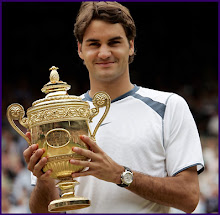A full shoulder turn, good balance, and tremendous racquet-head speed make this a much-feared weapon.
As the Wimbledon approaches near, let us take a look at the 3 time champion Roger Federer. On the list of all-time great forehands, Roger Federer’s should be near the top. It’s struck powerfully and has remarkable variety and adaptability. Of all the shots in his arsenal, it’s his forehand that he relies on most to win points. Whether he’s defending or attacking—as he’s doing in this sequence—Federer makes it all look effortless.
1. Federer is turning his shoulders as he’s moving to the ball. Notice how his left hand is on the racquet even though he’s well into his preparation. This forces him to turn his shoulders. Federer uses a semi-Western grip and he’s bringing his racquet back with the head cocked above the wrist. This will ensure a loop back-swing and good spin production. He’s moving diagonally forward, rather than straight to the side, so the ball doesn’t get away from him.
2. Federer brings his racquet back and his left hand comes off the throat but stays to his right side. That’s a big change from my day, when players such as Chris Evert had their non-dominant hand out front and pointing to the oncoming ball at this stage. Keeping your off hand on the same side as your racquet produces a fuller shoulder turn, which helps you get more racquet-head speed and a more powerful shot.
3. After taking a big stride to reach this point, Federer is now calculating the distance of his next step so the ball will be at the perfect point for contact. Although he’s preparing to hit a low ball, he’s taken his racquet back quite high. Federer’s left arm remains to the right side, still assisting in his shoulder turn. In this frame and the next one his rotation is so complete that you can see much of his back.
4. Federer is lowering his body with his legs (not bending at the waist) and starting to bring his racquet down. Notice how the racquet face is closed (the strings are facing down). This is due in part to his grip, but also because of the way he leads his backswing with his elbow, pronating his forearm. This type of take-back—another big change from the straight-back, straight-forward forehand of my day—allows you to produce tremendous racquet-head speed.
5. As he starts his forward swing, Federer begins to open his torso and bring his left arm around to the front of his body. The string bed is still facing the ground. The oncoming ball is low—you can tell because he’s looking down—but his head has barely moved throughout the sequence. Federer follows the ball by moving his eyes while keeping his head as still as possible.
6. Federer has opened up completely at this point and his body is facing his target. His racquet has come forward with tremendous speed and he’ll make contact at a point that’s even with his right foot. Notice how he keeps his left hand close to his body. Just as figure skaters pull their arms close to spin faster, Federer tucks in his left arm to help his upper body turn more quickly and to get more racquet-head speed. Here we also get a good look at his semi-Western grip.
7. Though he’s well past striking the ball, Federer’s eyes are still glued to the point of contact. This is one of the reasons Federer makes such consistent contact on his shots. His follow-through, which is to the side rather than extended out front, shows just how important rotation is in his forehand. In my era, ground strokes were more linear—straight back and straight forward.
8. The ball has been directed down the line and Federer is moving back toward the center of the court, probably with the intention of following this shot to the net if it isn’t an outright winner. He’s fi nished his forehand while maintaining his balance, which will allow him to make a smooth transition forward.


No comments:
Post a Comment